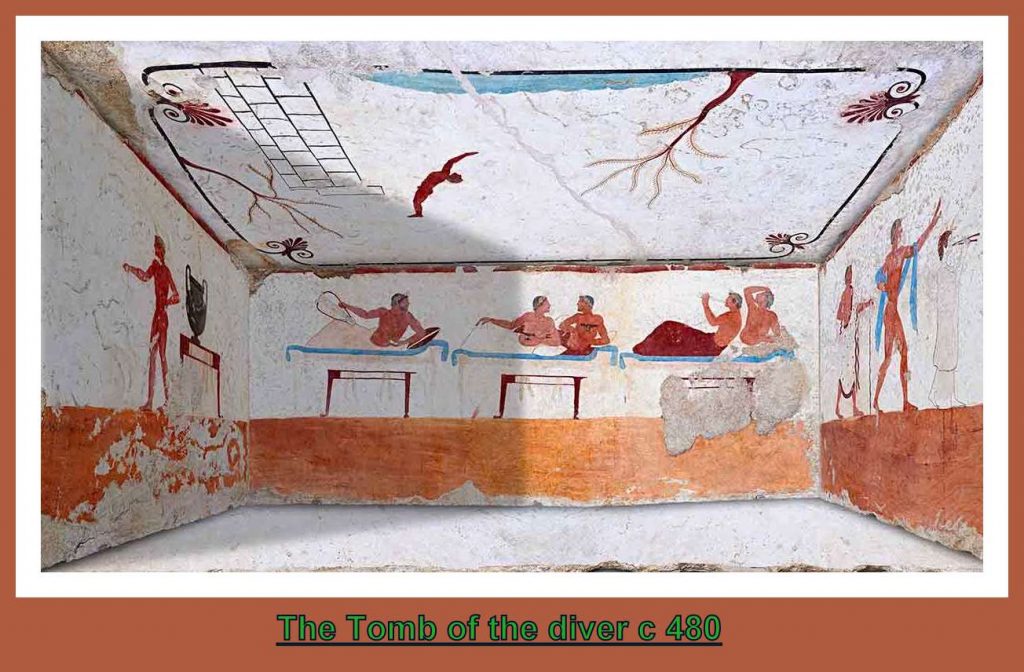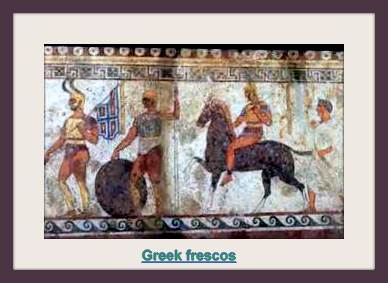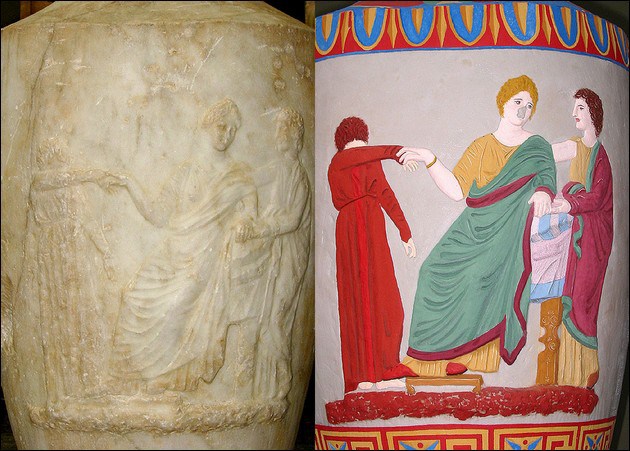Greek Painting in ancient times.
Very little is known of the Greek painters in ancient times, however, it is well know the mastery they could reach and manifested, as is also know the incredible realistic effects they produce by descriptions of some Roman writers annotations about the greek painters and the very few paintings that has survived. The Roman’s copies of Greek paintings also aport valuable informations, since they greatly appreciate their techniques and styles, coping and reproducing them even; many times the same work in different periods.
The paintings of ceramic vases and mural paintings discovered in Etruscan tombs; who imitated the work style and technique of Greek painters very well give us as well an idea on how they must have been realized
We can only see, some original Greek paintings features in the painting of their ceramic vases, that still remain in Museums and private collections, which decorations follow the bases characteristics of equilibrium and harmony, away from abrupted lines, carefully representing the sinuosity of the form in sophisticated fashion, like in the way the group the characters, the lines to accentuate the figures against the background, and others details. But unfortunately the richness in the palette used, the tones, the matiz and other aspects, can not be appreciated in their ceramic work due to the limitations of this technique.
It is know the names of many famous painters in ancient times and references of many of their works, but unfortunately, as we state before, they have not survived either.
Names of some ancient Greek painters:
– Polignoto – Apolodoro of Athens. – Agatarco of Samos. – Zeuxis Parrasio – Apelles.
Greek Painting in frescoes
Fresco Painting was a method widely used for decoration of the walls of temples, public buildings, houses and tombs. It should be noted however that this type of mural painting did not have the same level of reputation that panel painting had. Due to the perishable nature of these panels along with centuries of looting and vandalism, not a single Greek Classical panel painting of any quality has survived.
The mural was intended primarily to cover or disguise the imperfection of the walls; whose completion was not very smooth; because of the poor materials used in its lining. The themes treated in this type of painting were however similar to the one used on panel painting. In contrast to other ancient culture that also did fresco’s to decorated the uneven surfaces, the Greeks did not filled all the spaces in them; not leaving absolutely not space free like other cultures usually did. Greek remain loyal to the concept of balances, equilibrium, order and mathematical proportions in the fresco painting as well.
Among the examples of Greek fresco painting are some mural painting in Etruscan tombs discovered like the one shown below corresponding with the Tomb of the diver.

– The Tomb of the Diver at Paestum (c.480), a grave decorations in the Greek colonies in Italy.

– The Great Tomb at Verfina (c.326 BC), whose facade was decorated with a large wall painting of a royal lion hunt. This mural is noted for its subtle depictions of light and shadow as well as the use of a technique called Optical Fusion (the juxtaposition of lines of different colors).
Painting on the Greek sculptures.
Sculptures also were painted, the stone, terracotta and wood sculpture was another specialist technique mastered by Greek artists. Stone sculptures were typically painted in bold colors; mostly the part corresponding with the representation of the hair and the clothes, however the part corresponding to the skin lacks of painting, were stayed with the natural tone of the stone.
Sculptures were painted but not all its parts, rather only some; to highlight some elements, and that was done with taste and detail, with subtlety, enhancing the beauty and expressiveness of these sculptures in an impressive form. Sometimes all the sculpture was painted in a single color, and they were usually the one related to religious cult.

Based on micropigments remains on greek relief and sculptures; have been possible to obtain thanks to modern techniques a representation on how they must have been look like in ancient times.

Greek Painting Classical Period (400-323) BC.
Almost all pictorial forms flourished during the classical period of Greek art, panel painting is highly used in the in-caustic or tempera technique. The topics addressed mainly figurative scenes, portraits, and still life. Representations of mythology passages were also portrayed in them. Heroes and heroines are represented with the canons of ideal beauty, balanced proportions and softness of the lines.
Their rationality produces calm, balanced, they are away of nervous lines, crack forms or bold and unbalance elements, as well as sudden movements of the lines that can produce an uneasy feeling or uncertainty.

Their artworks; was mainly addressed to achieve the appreciation of beauty by the viewers and give joy to their spirits, they get to represent however; the sinuosity of the outlines of human figures and fine detail in the representation of nature; despite the idealism they convey as a way of represent forms in their ideal depiction, not because they don’t care about reality and the social challenges of living in a civilized society, they did it because in their philosophy of life; in order to represent an art that can be appreciate to the point of elevating the joy of the spirit, reality need to be sifted, filtrated and sweetened, no presented row and crude as human usually perceive reality.
During the golden period of Macedonian empire under the mandate of Felipe II of Macedon, father of Alexander the great, the Greek painting had its greater apogee with works of great quality.
There are pictorial experimentation and new techniques addressed to improve the use of shading, color and light to highlight the figures. Although the scenes were a sweet idealized fantasy of the imagination of the artist; they show great interest representing the detail of the elements of plants and animals in their paintings. The same apply as well to represent human figures as realistic as possible; as they did in other manifestations like sculpture, studying the real human features very carefully they obtained the best result. Different schools were created and their geographical location determine in some artistic tendencies of their artworks. Cartoon and genre painting are treated in this period also with success.
Greek painting. Hellenistic period.
During the Hellenistic period begins around the year 323 BC and coinciding with the death of Alexander the great, the Greek art transcends borders and times. In their constant journey to achieve perfection therefore; the Greek painters introduce in this period in order to reach a better communication with the viewers, certain movements in the lines to insinuate dynamic in the figures and to put emphasis in the emotions, although maintaining equilibrium without impetuous splits in the lines and forms. The light gets an important protagonist play highlighting the main characters in the compositions.
Artist achieve through repetitive intents; from the times of the Classical period, better results riching a better depictions of the location and proportion of the figures in their artworks that suggest a three dimensional scene. It reveals a grasp of linear perspective (Linear Perspective uses vanishing points and lines of conversions to give a picture space and depth) as well as a naturalist representation which would remain unsurpassed until the Italian High Renaissance.

From the 5th century BC we cannot appreciate the evolution of Greek painting taking as an example the ceramic decoration, because there will not be a correlation between them. The mosaics and some frescoes from Roman times, copies of the most famous Greek painters Apelles, “official” painter of Alexander the great, Soso of Pergamum , Teón or Filóxeno of Eritrea), show that their evolution continued to a greater naturalism, achieving in Hellenistic times the domain of the volume.
Greek art influence is well received even by the Romans; who appreciate and imitate the Greek art for a long time. Paintings by artists under the rule of the Roman Empire make many imitations produced to decorate palaces, temples and Roman public buildings; even in their colonies outside of Rome. Roman’s thou reinforced the purpose of political propaganda and religious characteristics, over the simple decoration purpose; for the joy and elevation of the spirit that the Greeks conferred to their art.
The Etruscan were very influenced by Greek painting style, mostly their paintings from the early periods, because they change slightly with time some characteristics regarding color, proportions, and relation between background and figures. (refer to the Etruscan painting post for more details.)


